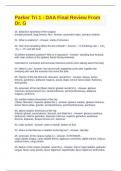Parker Tri 1 : DAA Final Review From
Dr. G
05. abduction (protract) of the scapula
(medial pectoral, long thoracic Nn) - Answer- pectoralis major, serratus anterior
01. What is anatomy? - Answer- study of structure
02. How does breathing affect the pH of blood? - Answer- ↑ in breathing rate: ↓ CO₂
↑O₂ = ↓ H+ and pH level
03.Define anatomic position? Why is it important? - Answer- standing face forward,
with volar surface of the (palms) hands facing anteriorly
important for consistent and accurate reference points when talking about the body
04. Hilton's Law - Answer- the nerve trunk supplying a joint also supplies the
overlying skin and the muscles that move the joint
05. Flexion of the hip (femoral, obturator, spinal Nn.) - Answer- iliacus, rectus
femoris, pectineus, adductor magnus, psoas major, tensor fascia latae, Sartorius,
and gracilis.
05. extension of the hip (tibial, inferior gluteal, sacral Nn.) - Answer- gluteus
maximus, biceps femoris LH, semitendinosus, semimembranosus, adductor
magnus, piriformis
05. medial rotation (inversion) of the hip
(Tibial, Obturator, Superior gluteal Nn.) - Answer- gluteus medius, gluteus minimus,
tensor fascia latae, gracilis, semitendinosus, semimembranosus, pectineus
05. lateral rotation (eversion) of the hip
(inferior gluteal, sacral plexus, femoral, and tibial Nn.) - Answer- gluteus maximus,
piriformus, inferior gemellus, obturator internus, superior gemellus, quadratus
femoris, iliopsoas, biceps femoris LH, Sartorius
03. volar surface - Answer- palm of hands, bottom of foot
03. where is the little toe in relation to the big toe? - Answer- laterally
05. extension of the carpus (radial n.) - Answer- EXTENSOR...
carpi radialis longus, carpi radialis brevis, digitorum comminis, digititi minimi, indicus,
pollicis brevis, carpi ulnaris
05. flexion of the carpus (median, ulnar Nn.) - Answer- Flexor carpi radialis, palmaris
longus, flexor carpi ulnaris, flexor digitorum superficialis, flexor digitorum profrundus
,05. flexion of the shoulder
(axillary, musculocutaneous, pectoral Nn.) - Answer- coracobrachialis, pectoralis
major, deltoid, biceps brachii
06. When do the fontanelles close? List first to last - Answer- Posterior (Lambda): 2
months
Anterolateral (Pterion): 3 months
Posterolateral (Asterion): 1 year
Anterior (Bregma): 2 years
07. name the sutures of the skull? and points of intersection? - Answer- ∙Coronal
Suture:
-connects r. pterion to l. pterion (bregma in middle)
- made of frontal, and R/L Parietal bone
∙Lambdoidal Suture:
-connects r. asterion to l. asterion (lambda in middle)
-made of occipipital, and R/L parietal bone
∙Sagital Suture:
-connects bregma to lambda
-made of R/L parietal bones
∙Squamous Suture:
-connects pterion to asterion
- made of temporal and parietal bone
∙Metopic Suture:
-extends from anterior fontanel to glabella
-ossifys by age 6
08. what bones form the pterion? - Answer- Parietal
sphenoid
temporal
frontal
09. the clivus is formed by what two bones? - Answer- sphenoid and occipital
10. where do the branches of CN5 trigeminal branches?
V1- Ophthalomic
V2- Maxillary
V3- Mandible - Answer- V1- Superior Orbital Fissure & supraorbital foramen
V2- Foramen Rotundum
V3-Foramen Ovale
10. What bones touch the sphenoid? - Answer- Frontal
Parietal
Temporal
Occipital
Vomer
Palatine
Ethmoid
Zygomatic
Maxilla
, 10. what hole does the facial nerve (CN7) pass through? - Answer- Stylomastoid
foramen
11. which of the curves in the spine are Primary and which are secondary? Why? -
Answer- primary (posterior): Thoracic and Sacral
secondary (anterior curves): Cervicle and Lumbar
∙IVD's are thicker anteriorally
12. What makes up the Intervertebral Foramen (IVF)? where is the first one/last one
found? - Answer- Superior vertebral notch of one vertebra and Inferor vertebral notch
of superor vertebra
(IVD forms anterior wall)
1st pair @ C2/C3
Last pair @ L5/S1
13. what forms the neural arch? - Answer- 2 pedicles and 2 lamina
14. angles of the facets on the cervical, thoracic, and lumbar vertebra? - Answer-
cervical- Transverse (flat) ↑body↑
thoracic- Oblique/coronal ↔ body ↔
lumbar- Sagital (diaginal-body-diagonal)
14. how many points of contact are there between 2 typical vertebra? - Answer- 3
15. how the ribs articulate with the vertebrae - Answer- costal facets of the thoracic
vertebrae.
-3 points per side, 6 total
(inferior, superior and transverse)
16. what boney landmark separates the anterior flexor from the posterior extensors
of the forearm? - Answer- posterior border of the ulna
16. what 2 carpal bones articulate with the radius? - Answer- lunate and scaphoid
bone
16. what bones make the acetabulum? - Answer- ilium, ischium, pubis (look at
spelling!!)
17. 5 characteristics of the synovial joint? - Answer- ∙joint cavity
∙Joint Capsule
-fibrous joint capsule (stratum fibrosum)
-stratum membrane (synovium)
∙synovial fluid
∙articular cartilage
17. 2 components of a joint capsule? - Answer- Stratum fibrosum (outer layer)
stratum synovioum (inner layer)
18. how do you classify the intervertebral (IVD) joint? - Answer- non-synovial




